The Fundamentals of Book Collecting: Unearthing Literary Treasures

Book collecting is more than just accumulating volumes; it’s a passionate pursuit of history, art, and storytelling. For new enthusiasts stepping into this rewarding hobby, the sheer volume of information can be overwhelming. What makes one old book valuable and another just… old? The answer lies in mastering the fundamentals: understanding a book’s edition, appreciating its completeness, and meticulously assessing its condition. These three pillars form the bedrock of any discerning book collection.
1. Edition of the Book: The Heart of Rarity
At the core of a book’s collectibility is its edition. Generally, the earliest edition of a book, especially the first edition, first printing, is the most sought-after and valuable. Why? Because it represents the book in its original form, as it was first presented to the world, often closest to the author’s initial intent.
How to Identify a First Edition:
- The Copyright Page is Key: Always turn to the copyright page, usually found on the back of the title page. Look for explicit statements like “First Edition,” “First Printing,” “First Published,” or “First Impression.”
- The Number Line: Many publishers, especially from the mid-20th century onwards, use a number line to indicate printings. A line like “1 2 3 4 5 6 7 8 9 10” or “10 9 8 7 6 5 4 3 2 1” signifies a first printing if the number ‘1’ is present. The lowest number in the line denotes the printing.
Exceptions to the Rule:
While the first edition, first printing is usually king, there are fascinating exceptions where later editions or printings can hold significant value:
- First Appearance of Illustrations: Sometimes, a later edition might be the first to feature iconic illustrations by a renowned artist. These can be highly collectible, especially if they are the first visual representation of a beloved story.
- Major Revisions or Additions: An author might significantly revise or add new material to a later edition. If these changes are substantial and critical to the work’s literary history, that specific later edition can become more valuable than an earlier, unrevised one. Think of a definitive annotated edition or a version with a crucial new preface.
- “First Thus” Editions: This term refers to the first appearance of a work in a particular format (e.g., the first hardcover edition after an initial paperback, or the first illustrated edition). While not a true first edition, these can be significant to collectors interested in a specific presentation.
- Limited or Signed Editions: A special limited edition, even if it’s not the very first printing, can be incredibly valuable, especially if it’s signed by the author or artist. These are often produced in small quantities with superior materials.
- Foreign or Translation Firsts: For some international collectors, the first edition of a book in their native language or the first foreign edition can be highly desirable, particularly for authors of global renown.
2. Completeness: As Close to Original as Possible
Collectors, especially those dealing in rare and vintage books, adore items that are as close to their original published state as possible. Completeness isn’t just about having all the pages; it’s about the entire package the publisher intended.
- The Dust Jacket: For books published after the 1920s, the dust jacket is paramount. A book without its original dust jacket can lose a substantial portion of its value—sometimes 75% or more. A clean, unclipped dust jacket is a treasure.
- Endpapers and Flyleaves: Ensure all original endpapers (the pages pasted to the inside covers) and free endpapers (the blank page following the endpaper) are present and undamaged.
- Illustrations and Maps: If the book was issued with plates, illustrations, or fold-out maps, verify that every single one is present and accounted for. Missing or damaged illustrations drastically impact value.
- Original Slipcases or Boxes: Some collectible sets or special editions were issued in slipcases or presentation boxes. The presence and condition of these original containers are vital to the set’s completeness and value.
- Associated Ephemera: Occasionally, a book might have been issued with bookmarks, promotional inserts, or even errata slips. If these are still present, they add to the book’s completeness and desirability.
3. Condition: The Art of Assessment
Even a first edition with all its original components can be diminished by poor condition. This is where meticulous assessment comes in. Book collectors use a standardized grading system, which we’ve explored in detail previously, but here’s a recap of what to look for:
- Dust Jacket: Examine for chips, tears, sunning (fading from light exposure), foxing (rust-colored spots), and any price clipping on the inner flap.
- Binding and Cover: Check for shelf wear (rubbing on edges), fading, fraying, loose hinges (where the cover attaches to the spine), and any warping.
- Text Block and Pages: Look for foxing, acidic browning (yellowing/brittleness), dampstains (water damage), annotations (writing by previous owners), and any dog-eared or torn pages. Ensure the pages are still tightly bound and not coming loose.
- Smell: While not always a deal-breaker, a musty or smoky smell can indicate poor storage conditions and may be difficult to remove, affecting the book’s appeal.
The Golden Rule: The better the condition, the higher the value. Collectors always seek books in the best possible state for their age. A “Fine” or “Very Good” condition book will always command a premium over a “Good” or “Fair” one, even for the same edition. For even more information on the key factors to look for when book collecting, visit this website.
Embarking on the journey of book collecting is a thrilling adventure. By understanding the nuances of edition, cherishing completeness, and meticulously assessing condition, you’ll not only build a valuable collection but also deepen your appreciation for the tangible legacy of literature. Happy hunting! Looking for some rare, or vintage books to add to your collection? Check out our online book store, where you will find, lots of options to choose from.
